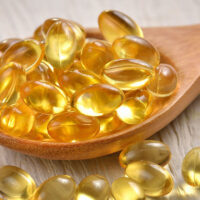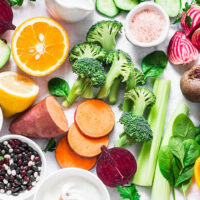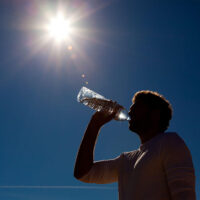The most popular of all recreational substances consumed on a number of different occasions, with a vast variety of flavours to choose from. Drunk during meetings with friends and family and accompanying humans since time immemorial, but not without significance for the body and health. Alcohol. Does it also affect your performance?
Going back to the basics, it can be concluded that moderate drinking can be healthy (within reasonable limits and on condition that you choose the right alcohol), but excess alcohol consumption causes damage to internal organs, serious diseases and accumulation of unwanted fat.
Calorific value of alcohol
The front runner, when it comes to the number of calories, is whisky (250kcal in 100g), with clear vodka being the first runner-up (220 kcal). Subsequent positions in the list are taken by beer (67 kcal) and wines: white (66 kcal) and red (60 kcal). It is worth noting, however, that wine and beer contain vitamins and minerals.
The circumstances in which you drink alcohol are of paramount importance. These include the amount of alcohol consumed, the food eaten together with the alcohol (or lack thereof), the high-calorie drinks drunk, etc. Since alcohol is rarely drunk alone, as a solitary glass of vodka, the analysis should be comprehensive, encompassing the background and other calories consumed together with the alcohol.
How alcohol affects your training capacity
Detailed tests were performed on the effects of alcohol consumed after intense training and before working out. In the former case, the dose was high and equalled 1.5g per 1 kg of body mass, while in the latter, two variants were considered, i.e. training under the influence of alcohol and working out 13 hours after consumption (hangover).
The results showed bigger alcohol impact on testosterone in men than on production of the hormone in women.
Therefore, it can be concluded that when combined with training, the effects of alcohol differ depending on the sex. Men are definitely advised to separate these two pleasures in time. Nonetheless, it must be noted that occasional consumption of alcohol is not strictly contraindicated when in a workout routine.
Alcohol and muscle mass
Unfortunately, studies on protein synthesis after alcohol consumption are sparse. Still, however, experiments on rats clearly show that muscle protein anabolism is reduced when in contact with the alcohol consumed. Simply speaking, alcohol slows down the pace of muscle growth.
As the study was performed on rats, and not on humans, the scale of the phenomenon is difficult to assess and the results are difficult to differentiate based on weight, sex, age or the amounts consumed, and cannot be translated directly into the loss or hindered growth of muscles. Nevertheless, the existence of such a relationship is unquestionable.
Alcohol and testosterone
Having analysed the muscle mass, we can now move to the endocrine system, which has been proved to be alcohol-dependent as well. Studies performed on humans showed that alcohol did not significantly lower the levels of testosterone in women, with some of the subjects reporting growth of the hormone. The results concerning men, however, are quite different.
Men who consumed 40g of alcohol within 24h (which is not a high dose), had low testosterone concentration (ca. 6.8%). Increase of the dose to 1.5 g per 1 kg of the body mass (i.e. app. 128 g for a man weighing 85 kg) caused testosterone reduction by 23%. The scale, if large amounts of alcohol are drunk regularly, is huge.
The effects of alcohol on other hormones, such as adrenaline, noradrenaline and cortisol, have been tested, too. The studies encompassed post-workout levels of these hormones in physically active men. Analyses showed lack of differences between men who consumed alcohol and those who worked out sober.
This shows that occasional consumption of insignificant amounts of alcohol does not produce any problems and does not change the level of hormones, including testosterone, while regular drinking reduces testosterone secretion.
Alcohol and electrolytes
This is yet another aspect to be considered. It is no secret that drinking alcohol produces a diuretic effect, leading to dehydration and a considerable loss of electrolytes. As the above is true for working out both “under the influence” and before the body returns to form, training right after partying is not recommended.
Alcohol and fat tissue
Once oxidised to acetic acid, alcohol gets into the blood. Excreted in trace amounts only in sweat, while breathing and in urine, it circulates in the body. This is how alcohol digestion begins, with the substance becoming the major food ingredient used by the body to produce energy. In the digestion process, other energy sources (proteins, fat) are marginalised. Most of the product is metabolised, while the rest (5%) is stored as fat. As can be seen, although considered to be rich in calories, alcohol tends to be demonised.
Enough of the numbers. What you should remember is that when drinking alcohol, we tend to eat more, first, because we usually drink during parties, sitting at tables laden with food and, second, because alcohol does not really inhibit the appetite.
Here, again, the results proved to be sex-dependent. Small, occasional portions of alcohol protect women against obesity, while excess consumption produces an opposite effect. At the same time, women who overuse alcohol are at risk of myopathy, a degenerative muscle disease.
When it comes to men, it was noted that those who drank more than 1 beer a day were more prone to developing abdominal obesity.
What we eat together with alcohol is not insignificant for fat reserve increase. This tendency was observed in alcoholics, in whose menus alcohol supplanted a number of high-calorie products, leading to weight and fat loss. Obviously, given the benefits and costs associated with alcohol, it should by no means be treated as a diet.
Alcohol vs. diet in a training plan
According to logic, occasional consumption of insignificant amounts of alcohol has basically no impact on diet as a whole. Nonetheless, you should never combine it with improper nutrients: with alcohol, the supply of proteins, fat and carbohydrates is lower, and your body receives fewer building blocks to use.
Furthermore, as body weight stabilisation depends on the appetite, you should not disregard alcohol in this respect. The research conducted showed that those who drank alcohol before meals ate bigger portions than those who only drank soft drinks. Plus, the first group felt satiated much later than the other group.
This seems insignificant for occasional drinking, but if you drink alcohol frequently, you will probably not avoid additional kilograms and nutrient deficiency.
Know where to stop
Basically, alcohol should not be demonised or brought down to the role of number one enemy of workouts. But only if used moderately and reasonably. Putting aside the numbers and statistics, it must be remembered that even if you have slept well at night, your general state after carousing will not help you do a good workout.




